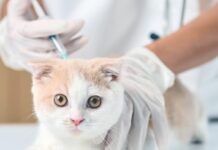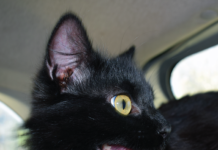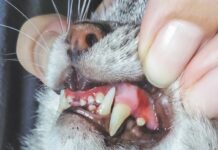An occasional bout of constipation that either self-resolves or resolves easily with simple treatment by your veterinarian is usually not cause for alarm. Frequent, repeat episodes, however, are a different story.
Constipation, defined as difficult and infrequent bowel movements usually associated with dry stools, can lead to obstipation, which is a total inability to move bowels. This leads to megacolon, defined as a massively dilated, flaccid, dysfunctional colon that can no longer contract to move feces. Obviously, we need to do everything we can to prevent the progression to megacolon, which is irreversible.
Constipation
Constipation is common in cats. Causes and contributing factors include underlying diseases resulting in dehydration (e.g., chronic kidney disease), obesity, environmental/behavioral issues resulting in reluctance to defecate in a timely fashion (stress, inter-cat aggression, poor litterbox maintenance, recent move to new home, etc.), anal gland issues, trauma or injury to the pelvic or anal area, and neurologic diseases.
“I would say that we see a handful of these cases each year at the Cornell University Hospital for Animals (CUHA),” says Dr. Alyssa Chandler, assistant clinical professor of small animal internal medicine at Cornell University’s College of Veterinary Medicine, “though I suspect that relatively low number is because the vast majority of these cases are managed locally by our outstanding referring veterinarians.”
Medical therapy can include fiber supplementation, stool softeners, and motility agents. “In cases of severe constipation or obstipation, patients may require hospitalization for fluid therapy, enemas, and manual deobstipation under general anesthesia,” says Dr. Chandler. “Often patients will respond initially to medical management but may become refractory to treatment over time.”
Prevention
Because many cats eventually stop responding to treatment for repeated bouts of constipation, serious effort must be put into prevention. If your cat has had more than one episode of constipation, your veterinarian likely will recommend a diagnostic work up, including bloodwork and X-rays, to rule out any underlying issues that must be addressed in order to prevent constipation.
After that, follow your veterinarian’s recommendations for general preventative measures you can take at home. These may include weight loss if indicated, canned food to improve daily hydration status, water fountains to increase interest in drinking, fiber supplementation (e.g., psyllium or pumpkin), stool softeners or daily laxatives, and prescription diets.
If Megacolon Happens
A cat with megacolon becomes a candidate for surgery. The surgery is kind of a big deal, but Dr. Daniel Lopez, board-certified veterinary surgeon and assistant clinical professor of small animal surgery at Cornell, encourages pet owners not to be afraid of this procedure.
“Surgical treatment of patients with megacolon is often reserved for patients who are unable to be successfully managed medically, with the definition of success being highly owner dependent and thus variable,” says Dr. Lopez.
“Given the loss of motility of the patient’s colon, surgery for megacolon entails surgical removal of either the majority or the entirety of the patient’s colon to promote overall motility,” says Dr. Lopez. “Given the perceived degree of invasiveness, the long-road to get to the point of surgery, the financial implications, and the historically perceived guarded-to-poor prognosis, we have not performed many subtotal colectomies for this disease process in the past 15+ years.”
Because Dr. Lopez knows this procedure can help save and improve the lives of countless cats suffering from megacolon, he is working toward changing the misconceptions surrounding this procedure.
“Given the infrequent surgical treatment of these patients, truly understanding the prognosis and outcome of these patients has proven difficult and has often led us to not recommending surgery with great gusto,” says Dr. Lopez.
“To better understand the impact of surgery and guide our recommendations, Cornell conducted a multi-institutional study to evaluate the long-term outcome of patients undergoing subtotal colectomy for idiopathic megacolon (meaning megacolon with no known underlying cause)*. Utilizing surgeons from across the country, we were able to evaluate the outcomes of 166 cats surgically treated for idiopathic megacolon. In our research, we surprisingly found that these patients can have a good prognosis with successful surgical treatment,” says Dr. Lopez.
“Where data were available, 90% of owners reported that they were happy with their decision to pursue surgery. With regard to quality of life, owners reported excellent quality of life in 38% of patients (no clinical signs without the need for medical or dietary management) and good quality of life in 39% of patients (no clinical signs with continued medical or dietary management). Therefore, approximately 80% of patients undergoing surgery demonstrated persistent improvement,” says Dr. Lopez. “Success appeared to be dependent upon surgical technique, whereas leaving a small remaining portion of colon (and subsequently preserving the ileocecocolic junction, a barrier between small and large intestine) resulted in improved fecal consistency (less diarrhea) and improved owner assessment.
“We often warn owners about the risk of intestinal dehiscence, which is where the reconnection between intestinal segments breaks down resulting in a life-threatening infection,” says Dr. Lopez. “Surprisingly, this complication risk was relatively low at about 2% in our study, as was the 10-day perioperative death rate of 5.6% (meaning about 95% of patients undergoing surgery survived longer than 10 days). In addition, the patients who survived the postoperative surgical period went on to live long lives. The median survival time following surgery (including any cause of death) was 1,254 days, and a survival time specifically related to the patient’s megacolon could not be reached.”
Bottom Line
“Utilizing an evidence-based approach, I now recommend surgical intervention for patients with idiopathic megacolon with the preservation of the ileocecocolic junction, as these patients can live long lives with good-to-excellent quality of life,” says Dr. Lopez. “Postoperative care often entails a few days of hospitalization, but is generally no different than that of a patient undergoing a spay, as recovery primarily focuses on incisional care. We do warn owners that patients may need to continue lifelong medical management as previously employed, however surgery has a good chance of improving the overall quality of life. Hopefully, with this new information, we can offer more patients quality treatment at Cornell.”
While the outcome of surgery may be positive, the importance of doing anything you can to help a cat who is battling constipation is clear. But if your efforts fail, there may be a light at the end of the tunnel in the form of surgery for your furry feline friend.ν
* “Evaluation of outcomes following subtotal colectomy for the treatment of idiopathic megacolon in cats”, Grossman RM, Sumner JP, Lopez DJ, et al, JAVMA, Dec 1, 2021, Vol 259, No. 11
Alyssa Chandler, DVM, is an assistant clinical professor of small animal internal medicine at Cornell.
Daniel Lopez, DVM is a board-certified veterinary surgeon and assistant clinical professor of small animal surgery at Cornell.




